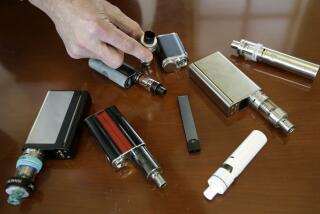300 La Habra High Students to Be Tested for TB : Health: County officials say family and co-workers of a senior at the school, who has been contagious since early last year, have already been screened.
- Share via
LA HABRA — Tuberculosis skin tests will be given next week to about 300 La Habra High School classmates of a senior female student discovered earlier this month to have a contagious form of the disease, county health officials said Friday.
Dr. Penny Weismuller, director of infectious-disease control for the Orange County Health Care Agency, said the student, whom she declined to identify, collapsed at a part-time job Jan. 5 and began coughing up blood.
The girl was taken to Friendly Hills Regional Medical Center, where tuberculosis was diagnosed and reported to county health authorities. Weismuller said the girl, who is in the advanced stages of tuberculosis, was sent home from the hospital Monday under medication and won’t return to school until laboratory tests show that her sputum is no longer infectious.
Tuberculosis is spread through the air, usually by coughing.
Weismuller said the student has been contagious at least since last February, when she sought treatment from a physician for a persistent cough. She said medical records show that the physician discovered the student had pneumonia, which did not respond to prescribed cough syrup or antibiotics.
Weismuller said classmates of the student as far back as the 1992-93 school year will be screened for the disease. Those classmates who have transferred to other schools are also being notified of the screening, she said.
Weismuller said that all but one of nine other people in the girl’s household have been screened for tuberculosis, and all but one were found to be infected, although the disease has not as yet affected their lungs.
In addition, Weismuller said, the student’s co-workers have been tested. Results on some of those tests are pending. However, two co-workers in closest contact with the student had positive skin tests, although their lungs were clear, she said.
“Because preliminary results indicate that persons who were close contacts of this student are infected, we are recommending skin testing of classmates of the last two years,” Dr. Hugh Stallworth, county health officer, said in a prepared statement.
Ron Anderson, assistant to the superintendent of the Fullerton Joint Union High School District, said the district has sent letters to parents of 300 students, “strongly recommending” that they take the skin tests to be given on the La Habra High campus Wednesday.
He added that on Friday the district also sent letters in English and Spanish to advise parents of the remaining 1,400 La Habra High students that their children do not need to be tested.
Weismuller said that although the infected student worked at a business that serves the public, customers who came briefly in contact with her are not at risk for contracting the disease. “Most cases of tuberculosis are due to close, prolonged contact,” she said.
Weismuller observed that those who may have contracted inactive tuberculosis infections usually can avoid the full-blown disease by taking preventive medication over six to nine months.
“People with positive skin tests have about a 10% chance of developing active disease in their lifetimes, and most who develop it will do so within the first two years after exposure,” she said.
Preventive medication, she said, can reduce by 70% to 90% the odds that the disease will become active.
After tuberculosis was discovered last year among students at La Quinta High School in Westminster, all 1,034 members of the student body and 189 staff members were tested for the disease. Seven cases of active TB were diagnosed in current and former students and 189 students tested positive for the bacterium.
A major difference at La Habra High School, Weismuller said, is that so far no additional active tuberculosis cases have been found, which may in part be attributed to the shorter exposure time. The student believed to have spread tuberculosis at La Quinta had the disease for three years before she got proper diagnosis and treatment.
Also, the tuberculosis bacteria strain at La Quinta resisted treatment by drugs. It will take two weeks before county health officers will receive results of laboratory tests to determine the kind of tuberculosis that has infected the La Habra High student, Weismuller said. However, she added that in both cases physicians had failed to readily diagnose tuberculosis in their patients. She said when the La Habra student’s pneumonia failed to respond to antibiotics, the physician should have ordered a sputum test.
While tuberculosis was once virtually eradicated in the United States, it has resurfaced in recent years, associated with the rise in homelessness, the outbreak of HIV and the immigration of people from Third World countries, such as Mexico and Vietnam, where tuberculosis is much more common.
It is necessary for physicians to be more alert to the possibility of tuberculosis, Weismuller said. “We will be working with the Orange County Medical Assn. and with the Vietnamese Medical Assn. and an association of Hispanic doctors to provide them additional information to raise their index of suspicion for tuberculosis,” she said.
More to Read
Sign up for Essential California
The most important California stories and recommendations in your inbox every morning.
You may occasionally receive promotional content from the Los Angeles Times.








